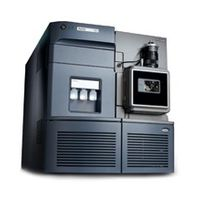Waters - Xevo TQ-S
Xevo® TQ-S from Waters is designed for the most demanding quantitative UPLC®/MS/MS applications. It features a...
Xevo TQ-S also features ScanWave™ collision cell technology to provide enhanced spectral LC/MS/MS data acquisition capabilities. Unlike conventional tandem quadrupole mass spectrometers, the Xevo TQ-S is designed to provide not only the very best quantitative data, but also superior spectral MS/MS information. You benefit from more versatility in a single instrument platform, which is adaptable to a wide variety of different UPLC/MS/MS applications both quantitative and qualitative: bioanalysis, ADME screening, food safety, environmental monitoring, forensic, and more.
Active Questions & AnswersAsk a Question
MS Detectors Service ProvidersView All (41)
Documents & ManualsView All Documents
Features of Xevo TQ-S
- Engineered Simplicity™ - the combination of highest performance with system versatility and simplicity of operation
- StepWave - a revolutionary off-axis ion source technology that is unique to Xevo TQ-S and delivers class leading UPLC/MS/MS sensitivity
- ScanWave - innovative technology that provides rapid, high quality, UPLC compatible, MS/MS data acquisition
- RADAR - an information rich acquisition approach that allows you to collect highly specific quantitative data for target compounds while providing the ability to visualize all other components
- Versatility - an extensive range of ionization capabilities to service the broadest range of applications
- Simplicity of operation - guarantees maximum system performance that is accessible to the broadest range of users
General Specifications
| Depth | 39 in |
| Height | 27.8 in |
| Mass Range | 2 to 2048 m/z |
| Width | 24 in |
| Scan Speed | 10000 amu/sec |
| Mass Spectrometer Type | Quadrupole Mass Analyzer |
Additional Specifications
System Hardware Specifications:
API sources and ionization modes: High performance ZSpray dual-orthogonal API sources:
1. Multi-mode source - ESI/APCI/ESCi (standard)
NB - Dedicated APCI requires an additional probe (optional)
2. APCI IonSABRE II probe (optional)
3. Dual model APPI/APCI source (optional)
4. nanoFlow ESI source (optional)
5. ASAP (optional)
6. APGC ion source (optional)
7. TRIZAIC ion source (optional)
Tool-free access to user serviceable elements
Plug-and-play probes
De-clustering cone gas
Software control of gas flows and heating elements
Ion source transfer optics: StepWave ion transfer optics delivering class leading UPLC/MS/MS sensitivity. The uniqe off-axis design dramatically increases the efficiency of ion transfer from the ion source to the quadrupole MS analyzer at the same time as actively eliminating undesirable neutral contaminants.
Mass analyzer: Two high-resolution, high-stability quadrupole analyzers (MS1/MS2), plus pre-filters to maximize resolution and transmission while preventing contamination of the main analyzers.
Collision cell: T-Wave enabled for optimal MS/MS performance at high data acquisition rates; ScanWave enabled for enhanced MS/MS spectral performance (product ion scanning); Software programmable gas control
Detector: Low-noise, off-acis, long-life photomultiplier detector
Digital dynamic range of 4x10^6
Vacuum system: Three air-cooled turbomolecular vacuum pumps; Two vacuum backing pumps
Regulatory approvals: CE and NRTL
Performance Specifications:
Acquisition modes:
Full scan MS
Product ion scan (ScanWave enhanced)
Precursor ion scan
Constant neutral loss scan
Selected ion recording (SIR)
Multiple reaction monitoring (MRM)
Survey scan modes: Full scan MS data acts as an automatic trigger for the collection of ScanWave-enhanced product ion spectra
Precursor ion scan data acts as an automatic trigger for the collection of Scan-Wave-enhanced product ion spectra
Constant neutral scan data acts as an automatic trigger for the collection of ScanWave-enhanced product ion spectra
Product ion confirmation (PIC) mode: MRM data acts as an automatic trigger for the collection of ScanWave-enhanced product ion spectra
RADAR: An information rich acquisition approach that allows you to collect highly specific quantitative data for target compounds while providing the ability to visualize all other components
Examples of achievable acquisition rates:
10 scans per second (m/z 50 to 1000)
20 scans per second (m/z 50 to 500)
Mass stability: Mass assignment will be within +/- 0.05 Da over a 24 hours period (the instrument must be operated in conformance with the laboratory environmental guidelines given in the Xevo TQ-S site perparation guide)
Linearity of response: The linearity of response relative to sample concentration, for a specified compound, is five orders of magnitude from the limit of detection
Polarity switching time: 20 ms to switch between positive and negative ion modes
MS to MS/MS switching time: 3 ms
ESCi mode switching time: 20 ms to switch between ESI and APCI
MRM acquisition rate: Maximum acquisition rate of 250 MRM data points per second;
Minimum dwell time of 1 ms per MRM channel;
Minimum inter-channel delay of 3 ms
Inter-channel cross talk: The inter-channel cross talk between two MRM transitions, acquired using an MRM dwell time of 1 ms and an inter-channel delay time of 3 ms, is less than 0.01%
Number of MRM channels: Up to 16,384 MRM channels (512 functions, 32 channels per function) can be monitored in a single acquisition; up to 8,000 MRM channels when operating in GLP/secure mode (250 functions, 32 channels per function)
Mass resolution: Automatically adjusted (IntelliStart) to desired resolution;
The valley between the m/z 2034.63 and m/z 2035.63 peaks is 195)
MRM sensitivity (ESI-) A 1 pg on-column injection of chloramphenicol will give a chromatographic signal-to-noise greater than 3000:1 (LC mobile phase flow rate of 0.8 mL/min, MRM transition m/z 321 >152)
MRM sensitivity (APCI+): A 1 pg on-column injection of 17-alpha-hydroxyprogesterone will give a chromatographic signal-to-noise greater than 100:1 (LC mobile phase flow rate of 0.8 mL/min, MRM transition m/z 331>109)
MRM signal-to-noise defition: Signal is defined as the height of the chromatographic peak of interest and noise is defined as the RMS of a continuous section of the mass chromatogram

